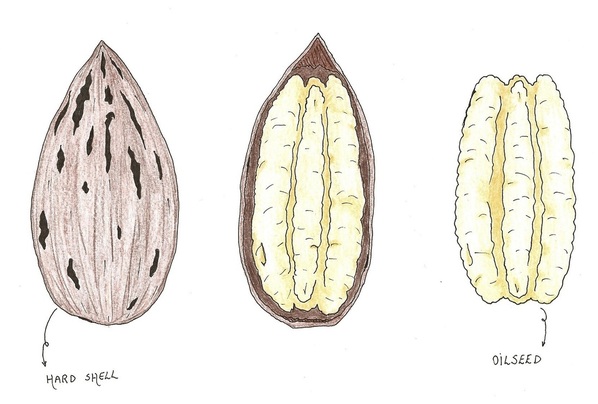I got preeeeetty excited yesterday while discussing Pecan Walnut Trees... So I decided to research a little more about Pecan Nuts! (I got so happy thinking about nuts that I began to wonder if I was a squirrel in a past life... But more on that later!)
Nuts in general are considered dry hard shell fruits, with one or two seeds (the eatable part). In the case of the Pecan Walnut Tree, its fruits are called drupe, which is a fleshy fruit type with a seed. That seed is so adhered to the endocarp (innermost layer of the fruit) that it has to be mechanically separated.
In fact, the word "Pecan", in Algonquian, means "a nut that requires a stone to crack". It's shell may be thinner than the common Nut's, but it sure is hard! I usually step on it very gently until I hear a little crack. After that, I peel the shell off with my fingers and voilà!
You can notice in my drawing that I referred to the seed as "oilseed". That's because walnut's seeds are very rich in fats, which got people a little bit worried in the past about eating a lot of them. Turns out that scientists found that the oilseeds had so many important substances (such as vitamins A, B1, B2; magnesium; phosphorus and calcium to name a few) that it was worth it. Not to mention that they help controlling the bad cholesterol and, therefore, are good for the heart. If you want to keep an eye out for your weight, though, you might want to consider eating only five nuts a day.
Last, but not least, I also found that Indians not only used to eat fresh Pecan Nuts but also used them as an ingredient in soups, cereal cakes, beverages and other foods. Among those aliments, there was "powcohicoria", a fermented "soup" they made out of crushed Pecan Nuts and water, which generated a very intoxicating drink, very popular in tribal festivals! Hummm, I might try that one someday!
Nuts in general are considered dry hard shell fruits, with one or two seeds (the eatable part). In the case of the Pecan Walnut Tree, its fruits are called drupe, which is a fleshy fruit type with a seed. That seed is so adhered to the endocarp (innermost layer of the fruit) that it has to be mechanically separated.
In fact, the word "Pecan", in Algonquian, means "a nut that requires a stone to crack". It's shell may be thinner than the common Nut's, but it sure is hard! I usually step on it very gently until I hear a little crack. After that, I peel the shell off with my fingers and voilà!
You can notice in my drawing that I referred to the seed as "oilseed". That's because walnut's seeds are very rich in fats, which got people a little bit worried in the past about eating a lot of them. Turns out that scientists found that the oilseeds had so many important substances (such as vitamins A, B1, B2; magnesium; phosphorus and calcium to name a few) that it was worth it. Not to mention that they help controlling the bad cholesterol and, therefore, are good for the heart. If you want to keep an eye out for your weight, though, you might want to consider eating only five nuts a day.
Last, but not least, I also found that Indians not only used to eat fresh Pecan Nuts but also used them as an ingredient in soups, cereal cakes, beverages and other foods. Among those aliments, there was "powcohicoria", a fermented "soup" they made out of crushed Pecan Nuts and water, which generated a very intoxicating drink, very popular in tribal festivals! Hummm, I might try that one someday!
~Ally

 RSS Feed
RSS Feed